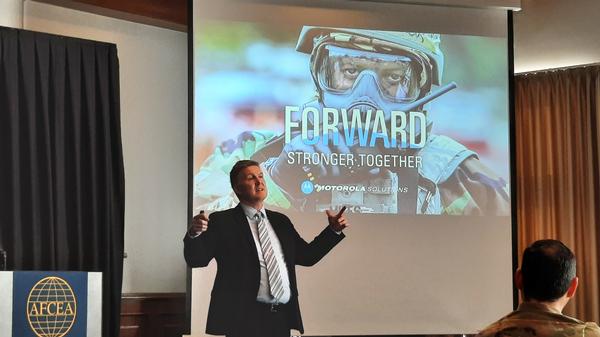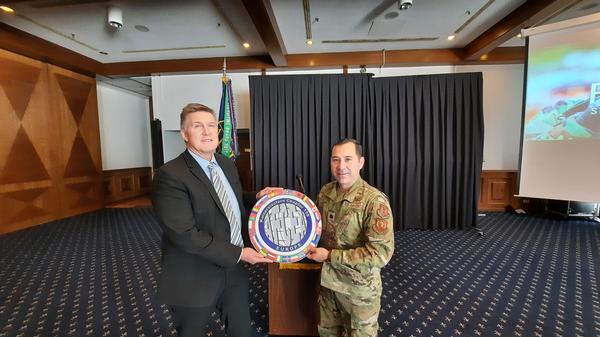In November, the chapter hosted John Pauls, a senior manager for Motorola Solutions Inc. He serves as the area sales manager for the U.S. federal government markets, U.S. Defense Department, Europe, Middle East, and Africa (EMEA) and the U.S. Department of State. Pauls is responsible for coordinating all facets of Motorola Solutions' business relationship with Defense Department customers in EMEA and Department of State customers globally. He visited this month's luncheon and educated the audience on radio frequency (RF) technology basics and the extraordinary promise this tech provides for future capabilities. Pauls began by introducing the discovery of RF in 1886, then continuing through to today's advancements, such as 4K video and the ability to pilot drones across the planet or even control a rover on a neighboring planet. He also mentioned some of the more common and easily ignored uses of RF, such as sensors on modern vehicles that detect other cars in the area to offer drivers collision prevention, brake assistance and lane departure avoidance.
Pauls spoke about the Industrial Internet of Things, which is effectively the ability of machines to talk to other devices. Some applications of this would be smart cities, smart public safety, and smart schools. Connecting all of the services that a city has to provide (such as parking, traffic, environmental, power and security) with each other can effectively allow a city to manage itself. Smart public safety, for instance, essentially acts as a force multiplier for lone police officers, acting as extra eyes and ears for the officer's safety while performing what could be a dangerous duty. A simple traffic stop can be supplemented by offering sensors reading the license plate and pulling up any additional warrant information on the driver and other sensors detecting people in the vicinity who could potentially pose a threat to that officer. Similar services could be provided for fire departments and emergency medical technicians. Artificial intelligence (AI) and augmented reality (AR) are developments of RF; the same technologies that can be applied to a smart city or smart public safety can be used on the battlefield via means of AI and AR. RF is also being developed for new capabilities that stack on top of existing ones, such as creating 8K video and 6G communication. Pauls said, "Things that we see in movies set in the future are things that we will be using 6G for." He suggested that we could soon see 16K, 360-degree video conferences with holographic images representing participants, for instance.
Lastly, Pauls discussed Motorola's new technologies, such as "software-defined radio." This innovation could be a notebook-sized device with six independent transceivers that can oscillate between frequencies ranging between 6 MHz and 6 GHz-all defined via software to use whichever waveform the customer desires, such as Land Mobile Radio (LMR) Long Term Evolution (LTE) or frequency hopping. This technology could allow a single device to send information via a wide array of radio protocols simultaneously in real time.
|




